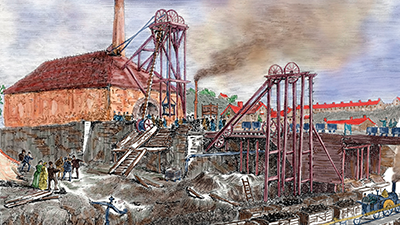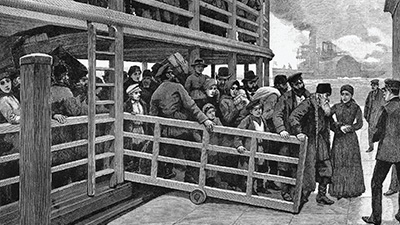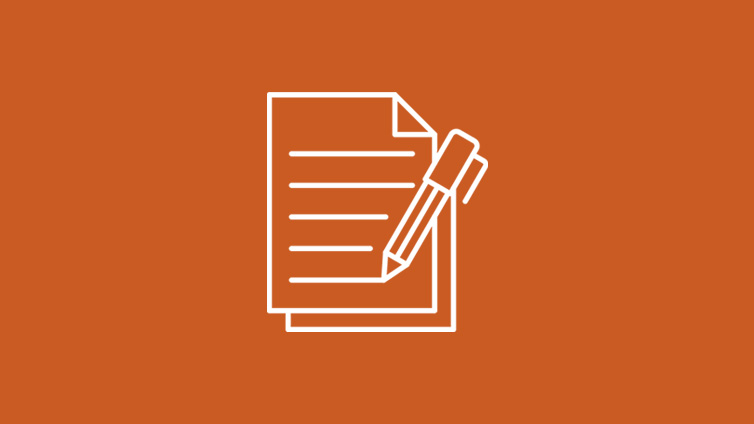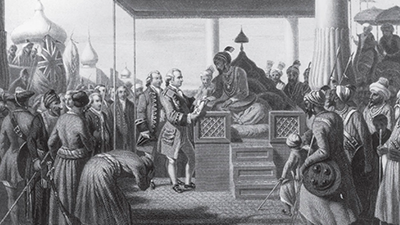Global Industrialization
Driving Question: How did industrialization spread to new regions of the world?
What happens when industrialization goes global? As you’ll see, change doesn’t always equal progress. Explore how industrialization reached new regions—and the effects it left in its wake. You live in a world that is almost completely industrialized. Now you get to investigate how it got that way.
Learning Objectives:
- Assess the scale of the Industrial Revolution and its impact on various regions of the world.
- Evaluate how the Industrial Revolution spread to a variety of global regions and how different nations adapted to changes in communities, networks, and production and distribution.
- Use the historical thinking practices of comparison and causation to analyze how industrialization happened in two different regions and explore how it affected migration.
Vocab Terms:
- capitalist
- deindustrialization
- enslaved
- exploitation
- imperialism
- migration
Opener: Global Industrialization
To teach this lesson step, refer to page 3 of the Lesson 3.4 Teaching Guide.
Would you stop the wheels of change if you could? Explore some hypotheticals to decide what—if anything—you’d do different if given the chance.
How Did Industrialization Change the World?
To teach this lesson step, refer to page 3 of the Lesson 3.4 Teaching Guide.
Want to dive deeper into the transformations sparked by the Industrial Revolution? Check out this blog post on industrialization and its impact on the modern world.
The Industrial Revolution transformed the lives of everyone living in Britain. But the transformation of the British economy had consequences for people in every corner of the world.
-
Guiding Questions
-
Before you read
Preview the questions below, and then skim the article. Be sure to look at the section headings and any images.
While you read
Look for answers to these questions:
- How did the Industrial Revolution change family structures in Britain?
- What roles did women and children play in the industrial economy? Did they benefit from factory labor?
- What kinds of benefits or opportunities did the Industrial Revolution create for people in Britain?
- How did the Industrial Revolution affect the daily lives and labor of people outside of Europe, such as enslaved Africans or colonial subjects?
- How did wheat power England’s factories, and how did the demand for wheat transform wheat-producing societies around the world?
After you read
Respond to this question: Imagine you’re a new wage-laborer who recently moved from a rural farm community to an industrial city. Using information from the article, explain how your life has changed. What new hardships or opportunities might you face?
Industrial Migration
To teach this lesson step, refer to page 4 of the Lesson 3.4 Teaching Guide.
Need a quick refresher on teaching causation? The Causation One-Pager has you covered with clear tips and strategies.
Don’t just take our word for it—this blog post, written by an experienced OER Project teacher, shares insights and strategies for teaching causation.
Industrialization allowed people to move around the globe in ways that were previously unimaginable. Read the article to explore the factors that caused migration, and then take what you’ve learned to put your causation skills to use in the activity.
-
Guiding Questions
-
Before you read
Preview the questions below, and then skim the article. Be sure to look at the section headings and any images.
While you read
Look for answers to these questions:
- How did industrialization influence migration patterns?
- How did industrialization drive urbanization?
- What are some major factors that the author gives to explain international migration?
- Why didn’t more Chinese and Indian migrants move to the Americas?
After you read
Respond to these questions: Is this history of migration in the nineteenth century “usable” in evaluating and thinking about migration today (meaning can you see similarities between migration then and now)? How, or why not?
Continuity and Change Over Time
To teach this lesson step, refer to page 7 of the Lesson 3.4 Teaching Guide.
This is your students’ first encounter with CCOT in the course—grab a quick refresher with the CCOT One-Pager.
These two activities will get your continuity and change over time (CCOT) skills up to speed, and they’ll then be put to use in an evaluation of the Industrial Revolution.
Closer: Global Industrialization
To teach this lesson step, refer to page 9 of the Lesson 3.4 Teaching Guide.
Hello from...anywhere! Pretty much everywhere was affected by industrialization. Write a postcard home explaining how.
Writing: Comparing Britain and India
To teach this lesson step, refer to page 9 of the Lesson 3.4 Teaching Guide.
The Writing Guide offers helpful support as students tackle this DBQ—and don’t forget to keep the OER Project Writing Rubric nearby for reference.
Document-based questions (DBQs) are a great way to improve your writing and deepen your historical thinking skills as you analyze texts to help build an argument. Analyze these documents describing the impacts of industrialization in Britain and India, and then create an argument.
Impacts in India
To teach this lesson step, refer to page 10 of the Lesson 3.4 Teaching Guide.
Doing business with Britain seemed like a good idea for India at the time, but one country’s industrial advances can have the reverse effect on another.
-
Guiding Questions
-
Before you read
Preview the questions below, and then skim the article. Be sure to look at the section headings and any images.
While you read
Look for answers to these questions:
- What effects did the industrialization of cotton cloth production have on the Indian economy?
- Why was deindustrialization a bad thing for India?
- What political explanations does the author give for this economic failure?
- Why did India suffer so many famines in the nineteenth century?
After you read
Respond to this question: How does an event like the deindustrialization of India support, extend, or challenge the production and distribution frame narrative?








